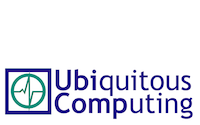IBSync: Intra-body synchronization and implicit contextualization of wearable devices using artificial ECG landmarks
Florian Wolling and Kristof Van Laerhoven

Description
With IBSync we have presented a novel method for the
intentional or incidental synchronization as well as the
implicit contextualization of wearable devices by touching,
approaching, or passing certain areas, surfaces, or objects.
Those are equipped with an embedded transmitter beacon that
capacitively induces artificial landmark signals into the
user’s body. Because no off-the-shelf intra-body communication
transceivers are available, the analog ECG front-ends of
commercial wearable devices have been repurposed. Those are
carefully designed regarding their energy efficiency and the
sensitive detection of tiny signals on the human skin. With a
synchronization error of 0.80±1.79 samples, or 6.25±14.00 ms at
a sampling rate of 128 Hz, we outperformed motion-based offline
synchronization methods with a typical error in the order of
250 down to 46 ms.
The provided data, which our evaluation is based on, contains
measurements from three experiments: 1)
ambient noise captured by the ECG AFEs; 2)
measurements from a controlled setting to evaluate the optimal
parameters and the system’s performance a) directly touching
the electrode, b) touching the desktop, and c) leaning back in
the office chair; 3) measurements from an
everyday life setting, demonstrating the feasibility and
applicability in-the-wild.
Download
The recorded measurements can be downloaded via the following link:
- IBSync Original Data (7.5 MB)
Citation
IBSync: Intra-body synchronization and implicit contextualization of wearable devices using artificial ECG landmarks, Florian Wolling and Kristof Van Laerhoven. Frontiers in Computer Science, 4, 2022. [pdf][scholar][bibtex][doi]
Disclaimer
You may use this data for scientific, non-commercial purposes, provided that you give credit to the owners when publishing any work based on this data. We would also be very interested to hear back from you if you use our data in any way and are happy to answer any questions or address any remarks related to it.
